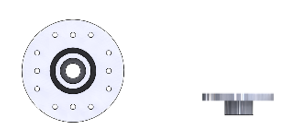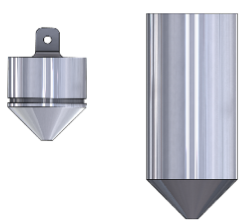Toothpaste dispenser
The blog will be divided in 3 parts:
Movement
Parts
Materials
Movement
The tooth paste dispenser is based on a crankshaft movement. The crankshaft movement is an easy, cheap and reliable movement and therefore a suitable solution. There is chosen to make the movement with bushes and not with bearings. The movement to fill one tooth brush is between two and four degrees in angle of engine rotation. That means that it takes at least 60 tooth brush fills before the engine made a 180 degrees turn, therefore is chosen that bearings are not required.
Parts
The parts will be mentioned from engine to the cylinder.
Engine
The engine is a servo motor with 180 degrees turning capability. The decision is made for the servo engine because it’s capable to stop every degree of engine rotation. The original engine attachment is used in the design.
Pushrod arms
The pushrod from the engine is five centimetres long to push all the toothpaste out of the cylinder. The arm between the piston and the engine pushrod is 12 centimetres long to prevent collision between the cylinder and the pushrod arm.
Bushes
The bushes are used to make the movement possible without too much friction and to give space to turn the engine 160 degrees without collision.
Piston and cylinder
The piston has a diameter of 40 millimetres. The form is chosen to push everything out of the cylinder. There is an indent made to add a O-ring. There is a difference of 0.6 millimetres between the cylinder and the piston, the O-ring will cover up the difference and take all thetooth-paste out.
Connection pushrod arm to piston:
The piston will be assembled with a M4 wing bolt for easily disassembling. The M4 nut will be glued in an engraved spot in the pushrod arm. The consumer will be able to refill the cylinder fast and easily.
Connection engine attachment to pushrod arm:
In the engine attachment are 12 holes of 1 millimetre, they are also added in the pushrod arm. The connection will be with 12 pins of 1 millimetre and they will be glued in place.
Materials:
The pushrod arms are made of 3 mm plywood because it is easy to fabricate and engrave.
The piston and cylinder are made of P.L.E.. The decision for this material is that is able to be 3d printed and the parts are expense to fabricate if they have to be formed out of metal.
Production plan manufacturing cylinder and piston
The cylinder will be printed without the brackets for mounting it to the base frame. The reason for this is that it’s cheaper to cut the mounts than to 3d print them. This also gives the opportunity to disassemble the cylinder.
The piston will be printed in two different parts. The reason for this is that the engrave of the part will be full of construction wires. There is a pin added to one side of the part and there is a hole added to the other side for easy connection without misalignment.